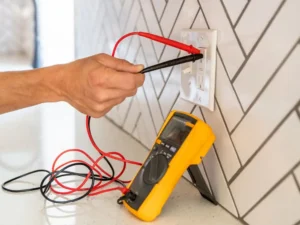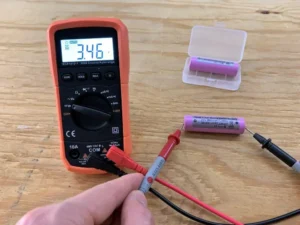Introduction:
Lithium-ion batteries have been included in our daily lives. They power an array of devices, from smartphones to electric vehicles. Despite their prevalence, these batteries are not immune to issues. Recognizing the signs of a failing lithium-ion battery is crucial. How to tell if a lithium ion battery is bad? This comprehensive guide will explore the various indicators of a problematic lithium-ion battery. We will also provide detailed steps to test its health using a multimeter.
How to tell if a lithium-ion battery is bad?

1. Rapid Discharge
A rapid discharge rate is one of the initial signs that your lithium-ion battery is damaged. You notice your device losing power even after a full charge. It suggests that the battery is struggling to maintain enough charge over time.
This phenomenon can be particularly frustrating. It is especially true when you depend on your device throughout the day. Rapid discharge hinders your device’s usability. And it also indicates an underlying problem with the battery’s ability to keep and deliver power.
2. Overheating
Another prominent red flag is excessive heat generation during battery use or charging. Some heat is normal. An abnormal temperature rise could cause internal issues within the battery. Pay attention to any noticeable increase in heat during regular operation.
Overheating affects the battery’s performance and can pose safety risks. Excessive heat may lead to thermal runaway. A situation where the battery temperature continues to rise. Your device becomes hot during use or charging. It is a clear sign that the battery needs closer inspection.
3. Swelling or Bulging
Physical inspection is a key aspect of determining battery health. Swelling or bulging in the battery’s casing is a clear sign of internal problems. A deformed battery points towards potential failure and poses safety risks. It includes the possibility of leakage or even explosion.
The swelling occurs due to the accumulation of gas inside the battery. Gasses are released when the internal components break down or become damaged, causing the battery to expand. Inspecting your battery for any signs of swelling or bulging is a simple yet effective way to identify potential issues.
4. Reduced Capacity
Frequent charging due to reduced capacity is common as lithium-ion batteries age. Over time, these batteries degrade, leading to a diminished ability to hold a charge. If you charge your device more than usual, it may indicate a declining battery.
Reduced capacity impacts the usability of your device. A battery that can’t hold a charge for an extended period not only disrupts your workflow. It also signifies that the battery’s health is compromised. Understanding the relationship between charging frequency and battery capacity is crucial.
Thus, this answers how to tell whether a lithium-ion battery is bad.
How to Test Lithium Ion Battery with Multimeter?
Testing the health of a lithium-ion battery is a straightforward process that involves using a multimeter. Let’s answer how to test lithium ion battery pack with multimeter.
1. Gather Your Tools
Before beginning the test, ensure you have all the necessary tools, including a multimeter. Always focus on safety and wear protective gear such as gloves and safety glasses.
The tools required for this test are available and can be found in most hardware or electronics stores. Investing in these basic tools can save you time and money.
2. Set the Multimeter

Configure your multimeter by switching it to the DC voltage setting. For precise results, set the voltage range to match your battery’s nominal voltage, which is around 3.7V for most lithium-ion batteries.
The multimeter is a versatile instrument used for various electrical measurements. Setting it to the appropriate voltage range ensures accurate readings and reliable results. Familiarizing yourself with your multimeter’s settings is essential for conducting a successful battery test.
3. Connect the Multimeter
Connect the multimeter probes to the battery terminals, ensuring that the positive and negative terminals align with the corresponding multimeter leads.
Proper connection is crucial for obtaining accurate readings. Ensure that the multimeter probes are attached to the battery terminals, preventing any interference or false readings. A stable connection is the foundation of a reliable battery test.
4. Read the Voltage

A healthy lithium-ion battery should read within the expected voltage range. If the voltage reading is lower than expected, it may say a failing battery that requires attention.
Understanding the expected voltage range for your specific battery is vital for interpreting the results. Deviations from this range can provide valuable insights into the battery’s health. Consistent monitoring and recording of voltage readings over time can help track changes and detect issues early on.
5. Observe Voltage Drop Under Load
To further assess the battery’s health, observe the voltage drop under load. It involves applying a temporary load to the battery, simulating real-world usage conditions. A healthy battery should maintain a stable voltage under load, while a failing battery may experience a significant drop.
Voltage drop under load is a practical test that reflects the battery’s ability to deliver power. It provides valuable information about the battery’s internal resistance and performance. Recording these observations can aid in identifying subtle issues. That may not be clear during regular voltage checks.
Conclusion:
Maintaining vigilance over the performance and physical condition of your lithium-ion battery is paramount. It ensures the longevity of your devices and, most importantly, your safety.
Employing simple testing methods, such as using a multimeter, you can take proactive steps. Address potential issues before they escalate. Regular monitoring and proactive maintenance are key to maximizing the lifespan of your lithium-ion batteries and ensuring the smooth operation of your devices.
Understanding how to tell if a lithium ion battery is bad empowers you. It lets you make informed decisions about when it’s time for a replacement. Moreover, it saves you from unexpected device failures and ensures a seamless experience. Stay informed, stay proactive, and enjoy the reliable performance of your lithium-ion battery-powered devices for years to come.
